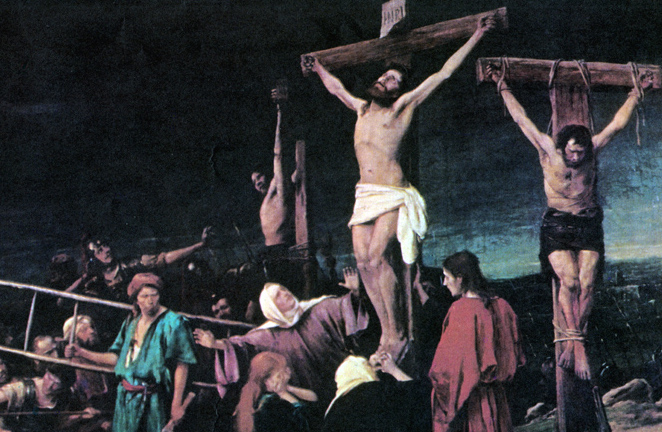A year ago on my first mission trip to Alaska, I led a little girl named Jennifer to Christ. This summer I served on the other side of the city, where Jennifer had happened to move after I left last year, and she found me. Though she seemed solid in her faith, she had a vexing question common among even more
mature believers: Why did Jesus have to die? Was there no other way?
No, Jennifer, there was no other way. Let me attempt to explain why.
God Is Not Cruel
He is holy and just and requires atonement for sin. When someone breaks the law, he suffers the penalty for his crime. You cannot rob a bank, lie under oath or punch someone in the face without the expectation of punishment. So it is with God.
Without shedding of blood there is no remission of sins. – Hebrews 9:22
Before Jesus, animal sacrifices were required for the temporary atonement of sins. The first example we see of this is in the Garden of Eden, where Adam and Eve – now ashamed of their nakedness – are clothed in animal skins (Genesis 3:21). We also see the same principle in God’s acceptance of Abel’s sacrifice and rejection of Cain’s (Genesis 4:4).
Upon exiting the ark, Noah “built an altar to the Lord, and took of every clean animal and of every clean bird and offered burnt offerings on the altar” (Genesis 8:20). And after Moses received the Ten Commandments, he “sacrificed young bulls as peace offerings to the Lord. Moses took half of the blood and put it in basins, and the other half of the blood he sprinkled on the altar” (Exodus 24:5b-6).
A Perfect Lamb
It was the blood of a perfect lamb that allowed the death angel to pass over the homes of the children of Israel in the final and most deadly plague to strike Egypt – the deaths of all firstborn animals and people.
Then Moses summoned all the elders of Israel and said to them, “Go at once and select the animals for your families and slaughter the Passover lamb. Take a bunch of hyssop, dip it into the blood in the basin and put some of the blood on the top and on both sides of the doorframe. None of you shall go out of the door of your house until morning. When the Lord goes through the land to strike down the Egyptians, he will see the blood on the top and sides of the doorframe and will pass over that doorway, and he will not permit the destroyer to enter your houses and strike you down. – Exodus 12:21-23
The Israelite tabernacle – whose architect was God Himself (Exodus 25-31) – was the place where God’s people could encounter God. It, its priests, its people, its altar and God’s word itself were consecrated with blood. Every year, a high priest would enter the Holy of Holies to make atonement for himself and his flock.
Now the first covenant had regulations for worship and also an earthly sanctuary. tabernacle was set up. In its first room were the lampstand and the table with its consecrated bread; this was called the Holy Place. Behind the second curtain was a room called the Most Holy Place, which had the golden altar of incense and the gold-covered ark of the covenant. This ark contained the gold jar of manna, Aaron’s staff that had budded, and the stone tablets of the covenant. Above the ark were the cherubim of the Glory, overshadowing the atonement cover. But we cannot discuss these things in detail now.
When everything had been arranged like this, the priests entered regularly into the outer room to carry on their ministry. But only the high priest entered the inner room, and that only once a year, and never without blood, which he offered for himself and for the sins the people had committed in ignorance. – Hebrews 9:1-8
The Mediator of a New Covenant
But that first covenant was imperfect and temporary. With all life upon earth born under the curse, even a spotless lamb was insufficient for the permanent remission of sins. It was man who had sinned; it was man who must take the punishment for his sins. But only a sinless man could take the punishment for all sins. And with sin passed on through sons of Adam (men), such a man would have to be God Himself, born of the Holy Spirit unto a woman untouched by man.
But when Christ came as high priest of the good things that are now already here, He went through the greater and more perfect tabernacle that is not made with human hands, that is to say, is not a part of this creation. He did not enter by means of the blood of goats and calves; but He entered the Most Holy Place once for all by His own blood, thus obtaining eternal redemption. The blood of goats and bulls and the ashes of a heifer sprinkled on those who are ceremonially unclean sanctify them so that they are outwardly clean. How much more, then, will the blood of Christ, who through the eternal Spirit offered himself unblemished to God, cleanse our consciences from acts that lead to death,so that we may serve the living God!
For this reason Christ is the mediator of a new covenant, that those who are called may receive the promised eternal inheritance—now that He has died as a ransom to set them free from the sins committed under the first covenant. – Hebrews 9:11-15
Jesus died so we wouldn’t have to as an overflow of His great love for us (Romans 5:8). Now let us die to ourselves and live for Him.



Good stuff, I can use this….